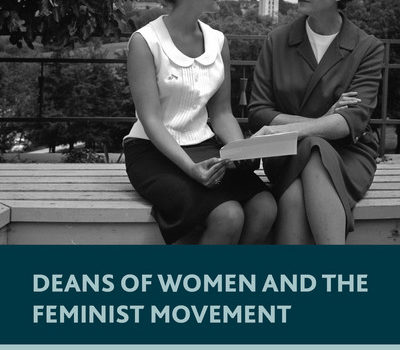 Deans of Women and the Feminist Movement: Emily Taylor’s Activism; Kelly C. Sartorius; Palgrave MacMillan Press (Historical Studies in Education) St. Martin’s Press; 2014.
Deans of Women and the Feminist Movement: Emily Taylor’s Activism; Kelly C. Sartorius; Palgrave MacMillan Press (Historical Studies in Education) St. Martin’s Press; 2014.
Remember when every coeducational college or university had a “Dean of Women”? It was a powerful and influential position, at least for the “coeds” under her charge (and it was always “her”). The dean of women was expected to provide guidance, protection and support for “coeds,” when women were a minority among undergraduates. How things have changed.
The position no longer really exists and perhaps with reason. Now that the majority of undergraduate students are women, unplanned pregnancy no longer is an impediment for women to completing college, marriage is less an expectation, and women have many more educational and professional opportunities than previously, one might consider the position of “Dean of Women” an anachronism, an historical artifact no longer needed. Indeed, women are now university presidents, academic deans and widely integrated into postsecondary education at all levels. But not so long ago, that was far from the case.
Until the 1970s, a dean of women was one of the very few professional roles for women in administration in postsecondary education, indeed in nearly all aspects of higher education. To get there and make any sort of difference in the lives of her charges, she had to be fierce. And foresighted.
As Kelly C. Sartorius writes in Deans of Women and the Feminist Movement, this (woman’s) position sometimes challenged itself and its charges. Until the feminist movement began on coeducational college campuses in the 1970s, female college students had, in many respects, only deans of women to shelter and protect them, to act in loco parentis, and if they were lucky, help them become individuals as well as females. While some of these deans provided career counseling aimed at making their charges able to support themselves financially, should the often-anticipated “Mrs” degree not materialize, much of their work was directed at caretaking and maintenance of female college students. But there were deans of women who looked out rather than in, and this is where Sartorius focuses her book.
By taking a close look at the life and career of a very activist dean of women at Kansas State University, Emily Taylor, the author presents the case that this “women’s profession” foreshadowed, indeed shaped, contemporary circumstances in higher education for women. It’s an interesting perspective. Could a dean of women who was something of an early if unspoken feminist—along with her dean colleagues at other colleges and universities—prepare, even shape themselves, their institutions and their students for the enormous social and political changes, feminism and changing expectations of and for women in particular, that many now take for granted?
Kelly Sartorius is herself a good example of the influence of those activist deans of women such as Emily Taylor—women who worked within the establishment toward and with the deep and broad social changes that started only four decades ago. While working as a university administrator (in development), Sartorius earned a doctorate in history; this book is based on her dissertation.
The book itself is a nice combination of well-researched, thoughtful historical perspective, and interesting reading. (For example, how did public universities and their female students shape antiwar activism, racial issues and radical feminism?) More importantly, it is documentation of how the then-few professional women in higher education accommodated or, as Sartorius argues, enabled changes in higher education that expanded the personal, social and professional development of young women in college.
Times have changed. It remains important to be aware of how much that is the case and how it happened. This book is a good reminder.
Reviewed by Jane Sjogren O’Neil, an educator, economist and consultant.
[ssba]
